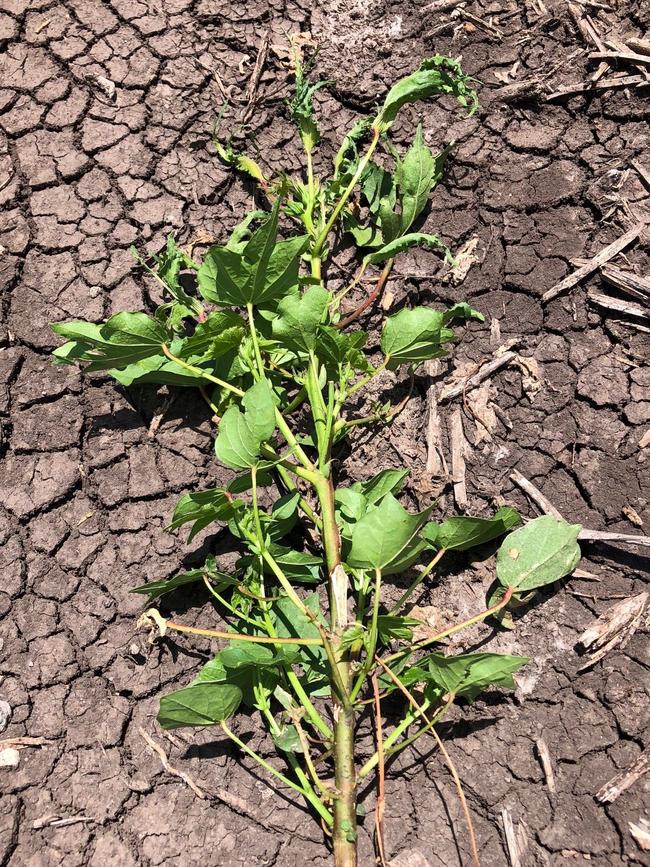‘Worst I’ve ever seen’: Farmers call for action on spray drift
Industry groups are pushing for more regulation of herbicides as cotton crops die. Some farmers say they should be banned.
Across vast tracts of NSW and Queensland, cotton plants that should be green and healthy are curling and withering on their stalks.
Climatic conditions this summer have created a “perfect storm” for chemical sprays to drift tens of kilometres through the air and into neighbouring paddocks, wreaking devastating results.
Moderate to severe incidents have been recorded from the Darling Downs in southern Queensland to the Riverina in southern NSW, and farmers say urgent action is needed to stop the damage.
Summit Ag director and consultant Emma Ayliffe said one of her clients in the NSW Riverina had lost 80 per cent of a 120ha crop to spray drift— a loss of an estimated $670,000 in inputs and expected yield.
“The level of damage that we’re seeing is bigger than one operator spraying on one inversion night. It is multiple operators spraying similar sort of chemistry and brews across a long period of time,” she said.

Inversion occurs when a layer of cool air over the earth’s surface, overlaid by a layer of warmer air, causes fine particles, like chemical sprays, to drift sideways rather than settle on the ground.
Darlington Point irrigator Matt Toscan, who has planted 1200ha of cotton on his Riverina property, said about 25 per cent of his crop had been affected by what he suspects was 2,4-D herbicide – commonly used by broadacre farmers to control weeds – sprayed by a farmer upwind.
In 12 years of growing cotton, this was the “worst drift we’ve ever seen”, he said.
Mr Toscan has called for a ban on the herbicide to stop growers turning away from the cotton industry.
“I think the easiest thing to do would be to take it (2,4-D) off registration,” he said.
“We’ve already got education (for correct use) and record-keeping … we’ve got a network of inversion towers (to warn when events are occuring).
“It’s not enough. We can’t keep doing the same thing over and over and expecting a different result.”

Industry groups that don’t want popular chemical sprays banned joined forces on Monday to issue a press release pushing for more regulation.
Cotton Australia’s Michael Murray said there was “no definitive scientific evidence in the form of residues analysis” to confirm which chemical was causing widespread damage to cotton crops in NSW and Queensland.
Together with Grain Producers Australia, the industry group called for “tougher laws and expanded enforcement activity” by regulators to ensure chemicals were used correctly.

Southern Valleys Cotton Growers Association chairman Paul Cleton said called for the NSW Environment Protection Authority to conduct random spot checks on farms and hand out larger fines to farmers who broke the rules.
“I know of crops that have been hit five, six, seven times (with herbicide this season).
“That has caused severe damage, and those crops are not going to grow any cotton at all.
“A lot of inputs have gone into growing this crop, and some growers are ropeable,” he said.
NSW EPA executive director of regulatory practice Tony Williams said the regulator was “concerned by recent reports of chemical spray drift” and would “roll out compliance and education activities in affected areas”.
The authority was now planning both announced and unannounced farm inspections to monitor for spray drift, he said.
Hard to track
The response to chemical spray drift is complicated by the fact that damage to crops can take weeks to appear after a spray event, and the farm responsible for damage can in some cases be more than 50km from an affected property.
Cotton Australia has asked all farmers to report spray drift damage to authorities.
When you sign up to #WAND (for free) you see the map of the hazardous weather warning system towers live across QLD & NSW. But there are more to come! This map shows the location of all 100: black= completed, green= soon to come! #spraysafe#ausag#agchatoz#stopofftargetsprayingpic.twitter.com/COnsUh36gM
— CRDC (@CottonResearch) January 22, 2023
In 2022, the Grains Research and Development Corporation announced $5.5m in funding for inversion monitoring towers to warn farmers when an event was taking place.
To date, dozens of towers have been installed across NSW and Queensland, but dozens more, mainly in Central NSW, are yet to come online.
More Coverage
â›…ï¸We hear not to spray under inversion conditions, but why is this?
— SOS Gwydir (@SOSGwydir) January 31, 2023
 @spraydriftgirl shows us a great demonstration of air movement under inversion conditions in this clip 👉https://t.co/poXFr3tyyo
Â
Find more spray drift resources on our SOS website!
 #StopOffTargetSprayingpic.twitter.com/TuM6MBylPo





